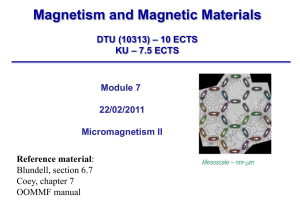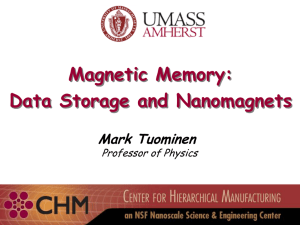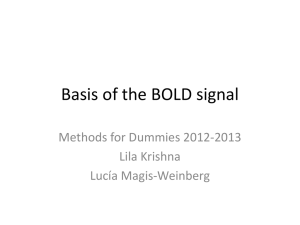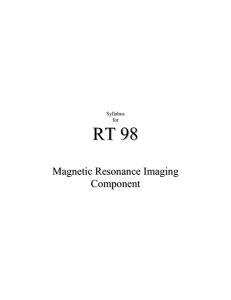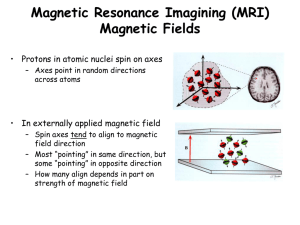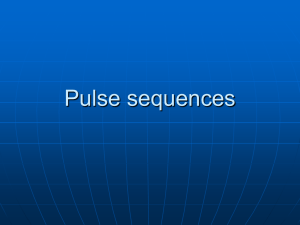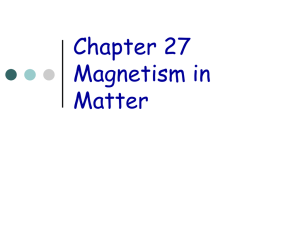FUNDAMENTALS OF MRI: - e
advertisement
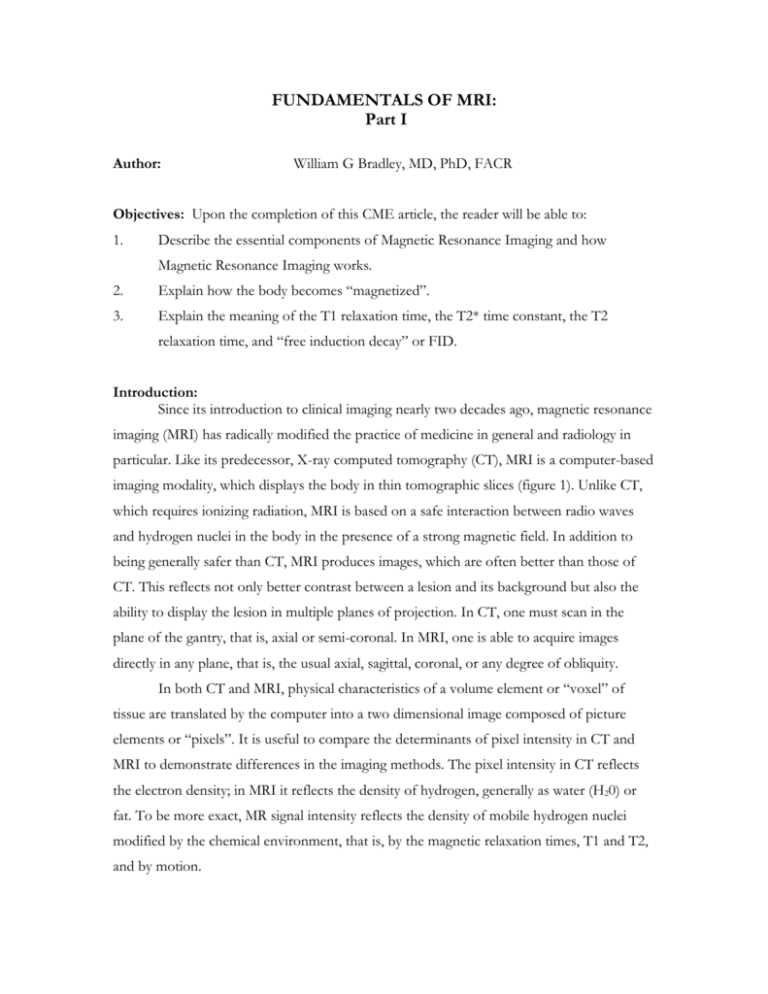
FUNDAMENTALS OF MRI: Part I Author: William G Bradley, MD, PhD, FACR Objectives: Upon the completion of this CME article, the reader will be able to: 1. Describe the essential components of Magnetic Resonance Imaging and how Magnetic Resonance Imaging works. 2. Explain how the body becomes “magnetized”. 3. Explain the meaning of the T1 relaxation time, the T2* time constant, the T2 relaxation time, and “free induction decay” or FID. Introduction: Since its introduction to clinical imaging nearly two decades ago, magnetic resonance imaging (MRI) has radically modified the practice of medicine in general and radiology in particular. Like its predecessor, X-ray computed tomography (CT), MRI is a computer-based imaging modality, which displays the body in thin tomographic slices (figure 1). Unlike CT, which requires ionizing radiation, MRI is based on a safe interaction between radio waves and hydrogen nuclei in the body in the presence of a strong magnetic field. In addition to being generally safer than CT, MRI produces images, which are often better than those of CT. This reflects not only better contrast between a lesion and its background but also the ability to display the lesion in multiple planes of projection. In CT, one must scan in the plane of the gantry, that is, axial or semi-coronal. In MRI, one is able to acquire images directly in any plane, that is, the usual axial, sagittal, coronal, or any degree of obliquity. In both CT and MRI, physical characteristics of a volume element or “voxel” of tissue are translated by the computer into a two dimensional image composed of picture elements or “pixels”. It is useful to compare the determinants of pixel intensity in CT and MRI to demonstrate differences in the imaging methods. The pixel intensity in CT reflects the electron density; in MRI it reflects the density of hydrogen, generally as water (H20) or fat. To be more exact, MR signal intensity reflects the density of mobile hydrogen nuclei modified by the chemical environment, that is, by the magnetic relaxation times, T1 and T2, and by motion. The hydrogen nucleus is a single proton. Since it is charged (positively) and since it spins, it generates a small magnetic field (a “magnetic moment”). Like a compass needle in the earth’s magnetic field, these magnetic moments align when placed in a larger magnetic field (figure 2). This allows them to display the phenomenon of nuclear magnetic resonance (NMR). Chemists and physicists have used NMR for over 50 years for chemical analysis. The equipment required to perform NMR consists simply of a strong magnet and a radio transmitter and receiver. When NMR is used for chemical analysis, the magnetic field across the test tube sample must be very, very uniform, often to one part in 100 million (0.01 ppm). When NMR is used for imaging it is called MRI and the magnetic field across the body-sized sample is intentionally made non-uniform by superimposing additional magnetic field gradients that can be turned on and off rapidly (figure 3). Activation of these additional magnetic fields results in a net gradient in the strength of the magnetic field across the body which is necessary for spatial localization and imaging. Thus, the essential components of an MR imaging system include: (1) a large magnet which generates a uniform magnetic field, (2) smaller electromagnetic coils to generate magnetic field gradients for imaging, and (3) a radio transmitter and receiver and its associated transmitting and receiving antennae or coils. In addition to these fundamental components, a computer is necessary to coordinate signal generation and acquisition and image formation and display (figure 4). Very simply, this is how MRI works: When the body lies in a magnet, it becomes temporarily magnetized. This state is achieved when the hydrogen nuclei in the body align with the magnetic field. When magnetized, the body responds to exposure to radiowaves at a particular frequency by sending back a radiowave signal called a “spin echo”. This phenomenon (NMR) only occurs at one frequency (the “Larmor frequency”) corresponding to the specific strength of the magnetic field. The spin echo signal is composed of multiple frequencies, reflecting different positions along the magnetic field gradient. When the signal is broken into its component frequencies (by a technique called a “Fourier Transform”), the magnitude of the signal at each frequency is proportional to the hydrogen density at that location, thus allowing an image to be constructed. Thus, spatial information in MRI is contained in the frequency of the signal, unlike X-ray-based imaging modalities such as CT. Magnetization: Immediately after being placed in a magnetic field, there is an equal number of protons pointing north and south or “parallel” and “anti-parallel” to the main magnetic field (figure 2). Thus, initially the individual magnetic moments cancel each other out. Within a few seconds (in biological substances), a redistribution occurs such that a slightly greater number of hydrogen nuclei (one in a million) align parallel to the field and the body is said to be “magnetized” (figure 5). Following placement in the magnet, magnetization increases exponentially with a first order exponential time constant known as the Tl relaxation time (which is the time it takes to recover 63% of the equilibrium magnetization) (figure 6). The magnetization ultimately plateaus at an equilibrium value that is dependent on the hydrogen density. Although at equilibrium the magnetization only points along the axis of the main magnetic field (defined as the z-axis), in general it can point in any direction (figure 7). The magnetization is a vector quantity that can be represented by a “longitudinal” component along the z and by a second component perpendicular to the first called the “transverse magnetization”, which is in the xy-plane (as seen in figure 7). Only transverse magnetization produces signal. Transverse magnetization results when an RF pulse tips the longitudinal magnetization away from the z-axis toward the transverse (xy)-plane. A 90 RF pulse tips the magnetization all the way into the xy plane (figure 8); a 180 RF pulse (twice as strong or twice as long as a 90 pulse), tips the magnetization so it’s pointing down, along the z-axis. A 90 pulse converts all longitudinal magnetization to transverse magnetization. However, unlike a 90 pulse, a 180 pulse cannot generate transverse magnetization. The maximum transverse magnetization (and the maximum signal) results from a 90 flip angle; flip angles less than 90 do not cause a loss of all longitudinal magnetization, and therefore they also produce less transverse magnetization per flip. However, since less time is needed for longitudinal recovery, they can be repeated rapidly, and generate more transverse magnetization (i.e. more signal per unit time). This is the basis for gradient echo imaging. Whenever transverse magnetization is present, it rotates or “precesses” like a top about the z-axis (figure 9) at the resonance (Larmor) frequency, which is also the frequency of the spin echo signal induced in the RF coil. Only the transverse component of magnetization rotates and can be detected; longitudinal magnetization does not rotate and cannot be detected directly. Two types of MR signals can be produced by transverse magnetization. Immediately following an RF pulse, a signal is produced by the freely rotating, decaying transverse magnetization. This signal is called a “free induction decay” or “FID” (figure 9). Transverse magnetization decays rapidly due to non-uniformities in the main magnetic field that cause protons to resonate at slightly different frequencies at slightly different positions within the voxel. As these protons get out of phase (i.e., “lose phase coherence”) transverse magnetization (and induced signal) is lost exponentially. The time constant of this decay is T2*. When a 90 pulse and a 180 pulse are applied sequentially, a spin-echo signal is generated (figure 10). The purpose of the 180 pulse is to “refocus” the phase of the protons, causing them to regain coherence and thereby to recover transverse magnetization, producing a spin echo. (Similar rephasing can be accomplished by symmetrically reversing the gradient fields, producing a “gradient” or “field echo”.) Following the spin echo, coherence is again lost as the protons continue to resonate at slightly different frequencies due to non-uniformities in the main magnetic field. If another 180 pulse is applied, coherence can again be established for a second spin echo. In fact, multiple spin echo signals can be produced if the original 90 pulse is followed by multiple 180 pulses (or gradient reversals). This “echo train” is illustrated in figure 11. Although the 180 pulses cause some rephasing to occur (that are due to fixed nonuniformities in the main field), complete rephasing is not possible due to randomly fluctuating magnetic fields within the substance itself. Thus, the maximum intensity of the spin echo signals in the echo train is limited by an exponentially decaying curve (figure 11). The time constant of this decay curve is the second magnetic relaxation time T2. T2* is always less than T2 because the former includes non-uniformities in the magnet as well as randomly fluctuating internal fields in the substance. T2 decay is only due to the fluctuating internal fields in the substance. In general, one must be careful to distinguish terms used to describe MR signals from those used to describe MR pulsing sequences because sometimes they are the same. An FID signal results from a terminal 90 RF pulse. A conventional spin echo signal results from a terminal 90-180 RF pulse pair. An inversion recovery (IR) sequence results from a 180- 90 pulse pair. (Since the final RF pulse in this IR sequence is a 90 pulse, an FID signal is produced. By adding a terminal 180 pulse, ie, 180-90-180, an IR sequence can produce a spin echo signal.) A traditional spin echo signal results from rephasing both temporally (by the 180 pulse) and spatially (by reversal of the readout gradient). The latter is accomplished by initially dephasing the spins along the readout axis and then rephasing them, producing a “gradient” or “field” echo. In CT and MRI, the manufacturer fixes certain parameters, and other parameters are under operator control. In MRI, the parameters that are determined by the manufacturer at the time of purchase or upgrade include the field strength (in Tesla) and the gradient strength (in milliTesla per meter: mT/m) and rise time (in sec). Factors under operator control include choice of pulsing sequence, sequence parameter times, matrix size, slice thickness and gap between slices, field-of-view (FOV), number of excitations, orientation of imaging plane, type of receiver coil, use of cardiac gating, use of contrast, etc. Improved spatial resolution in CT is generally associated with increased radiation dose. Spatial resolution in MRI can be calculated from the number of pixels along the x and y axis (i.e. the “acquisition matrix”) and the field-of-view. The field-of-view, in turn, is determined by the strength of the gradients and the specific range of frequencies (“bandwidth”) which is detected. For a given MR imaging system, increased spatial resolution (at a given signal-to-noise ratio, S/N) requires longer acquisition times but does not increase patient risk. Figures: 1 In MRI the body is displayed in thin, tomographic slices. 2 Protons align in an external magnetic field, pointing with or against it. 3 A magnetic field gradient is created by adding or subtracting the temporary magnetic field from an electromagnet from the main magnetic field. 4 Schematic of MR Imaging system including large magnet, gradients, radiofrequency subsystem, computer, and monitors. 5 A. Outside the magnetic field, the protons point randomly. B. When protons are placed in an external magnetic field, an equal number immediately align north or south (so their individual magnetic fields cancel). C. Over the next second or so in biological substances, a redistribution occurs such that a slightly greater number (one in a million) point north, creating Magnetization. 6 T1 Relaxation. Initial magnetization or recovery of magnetization after a radiofrequency pulse occurs with an exponential time constant T1 (which is the time it takes to recover 63% of the equilibrium magnetization). 7 Magnetization. Magnetization is a vector quantity with a component in the transverse (xy) plane (which generates signal) and a component along the longitudinal z axis (which does not). 8 A 900 Radiofrequency (RF) pulse tips all the longitudinal magnetization from the zaxis into the transverse (xy) plane. 9 Precessing transverse magnetization produces a decaying signal (called a "free induction decay" or "FID") as the spins lose the phase coherence induced by the 900 pulse. 10 Spin Echo. A spin echo signal results from a 900 RF pulse followed by a 1800 pulse which refocuses the dephased spins up to a decay curve determined by the T2 relaxation time. 11 A succession of four 1800 pulses produces a train of four spin echoes, all limited by the T2 decay curve. References or Suggested Reading: 1. Holland GN, Hawkes RC, Moore WS, et al. Nuclear magnetic resonance (NMR) tomography of the brain: coronal and sagittal sections. J Comput Assist Tomogr (1980) 4:429-33. 2. Croks LE, Arakawa M, Hoeninger JC, et al. NMR whole body imager operating at 3.5 kgauss. Radiology (1982) 143:169. 3. Bydder GM, Steiner RE, Young IR et al. Clinical NMR imaging of the brain: 140 cases. ASNR (1982) 139: 215-36; AJNR (1982) 3:459-80. 4. Wehril FW, Macfall J, Newton TH. Parameters determining the appearance of NMR images. In: Newton TH, Potts DG, eds. Advanced Imaging Techniques, Vol. II. (Clavadel Press: San Francisco 1983) 81-118. 5. Bradley WG, Waluch V. Blood flow: magnetic resonance imaging. Radiology (1985) 154:443-50. 6. Waluch V, Bradley WG. NMR even echo rephasing in slow laminar flow. J Comput Assist Tomogr (1984) 8(4):594-8. 7. Bradley WG, Waluch V, Fernandez E, et al. The appearance of rapidly flowing blood. AJNR (1984) 143:1167-74. 8. Bradley WG, Crooks LE, Newton TH. Physical principles of NMR. In Newton TH, Potts DG, eds. Advanced Imaging Techniques, Vol II. (Clavadel Press: San Francisco 1983), 1562. 9. Nalcioglu 0, Cho ZH, Lee SY, et al. Fast hybrid 3D imaging by small tip angle excitation. Magn Reson Imaging (1986) 4:103. 10. Frahm J, Haase A, Matthaei D, et al. FLASH MR imaging. Magn Reson Imaging (1986) 4:104. 11. Bydder GM, Young IR. Clinical use of the partial saturation and saturation recovery sequences in MR imaging. J Comput Assist Tomogr (1985) 9(6):1020-32. 12. Fullerton GD, Cameron IL, Ord VA. Frequency dependence of magnetic resonance spin-lattice relaxation of protons in biological materials. Radiology (1984) 151:135-8. 13. Bradley WG, Schmidt PS. The effect of methemoglobin formation on subarachnoid hemorrhage. Radiology (1984) 153:166. 14. Brasch RC. Methods of contrast enhancement of NMR imaging and potential applications. Radiology (1983) 147:781-8. 15. Gomori JM, Grossman RI, Goldberg HI, et al. Intracranial hematomas: imaging by high-field MR. Radiology (1985) 157:87-93. 16. Graif M, Bydder GM, Steiner RE, et al. Contrast-enhanced MR malignant brain tumors. AJNR (1985) 6: 85562. 17. Rosen BR, Pykett IL, Brady TJ. Spin-lattice relaxation time measurements in two dimensional NMR imaging: corrections for plane selection and pulse sequence. J Comput Assist Tomogr (1984) 8:195-9. 18. Le Jeune JJ, Gallier J, Rivet P, et al. Is an interpretator proton relaxation times in biological tissue possible? (abstract) Reson Med (1984) 1:192. 19. Wesby GE, Mosely ME, Ehman RL. Translational molecular self-diffusion in magnetic resonance imaging: effects and applications. James TL, Margulis AR, eds. Biomedical Magnetic Resonance. (University California Press: San Francisco 1984) 63-78. 20. Feinberg DA, Crooks LE, Hoenninger IC, et al. Contiguous thin multisection MR imaging by two-dimensional Fourier. transform technique. Radiology (1986) 158:811-17. 21. Bradley WG, Kortman KE, Crues JV III, et al. Central nervous high-resolution magnetic resonance imaging: effect of increasing resolution on resolving power. Radiology (1985) 156: 93-8. 10-9-00 About the Author: Dr. William Bradley currently is the director of the Magnetic Resonance Imaging Center at Long Beach Memorial Medical Center, in Long Beach, California. He is also a Professor of Radiology at the University of California, Irvine. He actively teaches Magnetic Resonance Imaging to medical students, Radiology residents and fellows in Radiology. Dr. Bradley has over 100 publications in peer-review journals and is actively involved in research in the filed of Magnetic Resonance Imaging. He has presented his research and has given lectures on MRI topics at major conferences around the country as well as internationally, including Europe, Japan, and India. Examination: 1. MRI is based on a safe interaction between radio waves and _________ in the body in the presence of a strong magnetic field. A. echo response B. hydrogen nuclei C. echo delay time D. carbon nuclei E. signal return 2. MR signal intensity reflects the density of mobile hydrogen nuclei modified by the chemical environment, that is, by A. the magnetic relaxation times, T1 and T2 B. the voxel C. motion D. A & B above E. A & C above 3. The hydrogen nucleus is a single proton. Since it is charged (positively) and since it spins, it generates a small magnetic field called a A. “magnetic moment” B. “voxel moment” C. D. E. “Larmor moment” “decay moment” none of the above 4. Chemists and physicists have used nuclear magnetic resonance (NMR) for over 50 years for chemical analysis. When NMR is used for chemical analysis, the magnetic field across the test tube sample must be very, very uniform, often to A. one part in a million B. one part in 10 million C. one part in100 million D. one part in 100 thousand E. none of the above 5. The essential components of an MR imaging system include A. a large magnet which generates a uniform magnetic field B. smaller electromagnetic coils to generate magnetic field gradients for imaging C. a radio transmitter and receiver and its associated transmitting and receiving antennae or coils D. a computer E. all of the above 6. Very simply, this is how MRI works: When the body lies in a magnet, it becomes temporarily magnetized. This state is achieved when the hydrogen nuclei in the body align with the A. spin echo B. Larmor frequency C. Fourier transform D. magnetic field E. none of the above 7. When magnetized, the body responds to exposure to radiowaves at a particular frequency by sending back a radiowave signal called a “spin echo”. The spin echo signal is composed of multiple frequencies, reflecting different positions along the magnetic field gradient. When the signal is broken into its component frequencies (by a technique called a _____________), the magnitude of the signal at each frequency is proportional to the hydrogen density at that location, thus allowing an image to be constructed. A. “Larmor Transform” B. “Fourier Transform” C. “Magnetic Transform” D. “Decay Transform” E. “Holland Transform” 8. Immediately after being placed in a magnetic field, there is an equal number of protons pointing north and south or “parallel” and “anti-parallel” to the main magnetic field (figure 2). Thus, initially the individual magnetic moments cancel each other out. Within a few seconds (in biological substances), a redistribution occurs such that a slightly greater number of hydrogen nuclei (____________) align parallel to the field and the body is said to be “magnetized” A. one in a thousand B. one in ten thousand C. one in a hundred thousand D. one in a million E. one in ten million 9. The Tl relaxation time is A. the time it takes to recover 63% of the equilibrium magnetization. B. the time it takes to recover 93% of the equilibrium magnetization. C. the time it takes for the computer to process the transmitted information. D. the time it takes to recover 33% of the equilibrium magnetization. E. the time constant of the echo train decay curve. 10. Although at equilibrium the magnetization only points along the axis of the main magnetic field, in general it can point in any direction. The magnetization is a vector quantity that can be represented by a “longitudinal” component along the ______. A. z-axis. B. x-axis. C. y-axis. D. xy-plane. E. xyz-plane. 11. Only ______________ magnetization produces signal. A. positively charged B. negatively charged C. transverse D. longitudinal E. z-axis 12. A _________ Radiofrequency pulse converts all longitudinal magnetization to transverse magnetization. A. less than 900 B. greater than 900 C. 900 D. 1800 E. less than 1800 13. Whenever transverse magnetization is present, it rotates or “precesses” like a top about the z-axis (figure 9) at the resonance (_______) frequency, which is also the frequency of the spin echo signal induced in the RF coil. A. Fourier B. Larmor C. Holland D. Newton E. Fullerton 14. Two types of MR signals can be produced by transverse magnetization. Immediately following an RF pulse, a signal is produced by the freely rotating, decaying transverse magnetization. This signal is called a (an) ________________. A. T1 relaxation time B. T2* constant C. T2 relaxation time D. free induction decay or FID E. IR sequence 15. Transverse magnetization decays rapidly due to non-uniformities in the main magnetic field that cause protons to resonate at slightly different frequencies at slightly different positions within the voxel. As these protons get out of phase, transverse magnetization is lost exponentially. The time constant of this decay is called the _______. A. T1 relaxation time B. T2* constant C. T2 relaxation time D. free induction decay or FID E. IR sequence 16. Following the production of a spin echo, coherence is again lost as protons continue to resonate at slightly different frequencies due to non-uniformities in the main magnetic field. If another 180 pulse is applied, coherence can again be established for a second spin echo. In fact, multiple spin echo signals can be produced if the original 90 pulse is followed by multiple 180 pulses. This is called ________. A. an echo train B. free induction decay C. a T2* constant D. a T1 constant E. a Larmor frequency 17. Although the 180 pulses cause some rephasing to occur (that are due to fixed nonuniformities in the main field), complete rephasing is not possible due to randomly fluctuating magnetic fields within the substance itself. Thus, the maximum intensity of the spin echo signals in the echo train is limited by an exponentially decaying curve. The time constant of this decay curve is called the ___________. A. T1 relaxation time B. T2* constant C. T2 relaxation time D. free induction decay or FID E. IR sequence 18. In CT and MRI, the manufacturer fixes certain parameters, and other parameters are under operator control. In MRI, the parameters that are determined by the manufacturer at the time of purchase or upgrade include A. the field strength (in Tesla) B. the gradient strength (in milliTesla per meter: mT/m) C. D. E. the rise time (in sec) all of the above none of the above 19. In MRI, factors under operator control include A. the choice of pulsing sequence and matrix size B. the field strength and the gradient strength C. sequence parameter times and slice thickness and gap between slices D. A & B above E. A & C above 20. Improved spatial resolution in CT is generally associated with increased radiation dose. For a given MR imaging system, increased spatial resolution (at a given signalto-noise ratio, S/N) requires A. shorter acquisition times but does not increase patient risk. B. longer acquisition times but does increase patient risk. C. shorter acquisition times but does increase patient risk. D. longer acquisition times but does not increase patient risk. E. none of the above.


